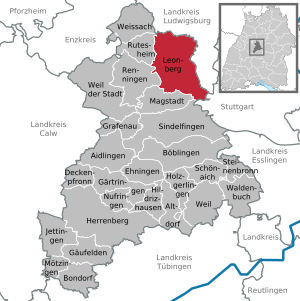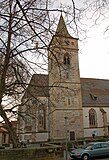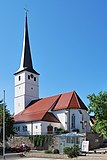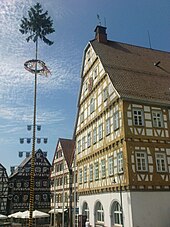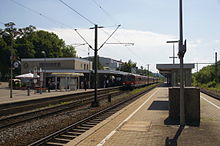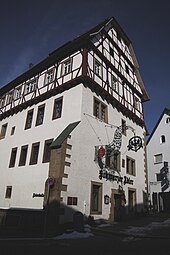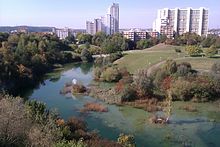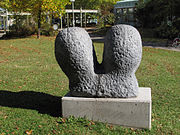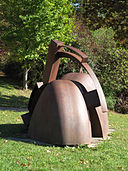Leonberg
| coat of arms | Germany map | |
|---|---|---|

|
Coordinates: 48 ° 48 ' N , 9 ° 1' E |
|
| Basic data | ||
| State : | Baden-Württemberg | |
| Administrative region : | Stuttgart | |
| County : | Boeblingen | |
| Height : | 386 m above sea level NHN | |
| Area : | 48.74 km 2 | |
| Residents: | 48,733 (Dec. 31, 2018) | |
| Population density : | 1000 inhabitants per km 2 | |
| Postal code : | 71229 | |
| Area code : | 07152 | |
| License plate : | BB, LEO | |
| Community key : | 08 1 15 028 | |
City administration address : |
Belforter Platz 1 71229 Leonberg |
|
| Website : | ||
| Lord Mayor : | Martin Cohn ( SPD ) | |
| Location of the city of Leonberg in the Boeblingen district | ||
Leonberg is a city in the middle of the state of Baden-Württemberg , about 13 kilometers west of Stuttgart . With about 48,000 inhabitants, it is after Sindelfingen and Böblingen the third largest city of Böblingen district and as a regional center designated for the surrounding communities. Leonberg has been a major district town since October 1, 1963 and was the seat of the district of the same name until 1973 , which was dissolved in the course of the district reform in 1973 .
geography
Geographical location
Leonberg lies above the right slope of the Glems Valley , on a spur, a spur of the Engelberg , which in turn is part of the Glemswald . Coming from Stuttgart in the southeast, the Glems enters the urban area, then flows to the northwest, turns to the northeast near the Eltingen district, then flows through the western core city (the old town is to the right of the river), then south past the Höfingen district and leaves the urban area in North-east towards Ditzingen again.
The northern districts of Höfingen and Gebersheim are part of the Strohgäu .
Neighboring communities
The following cities and communities border the city of Leonberg. Starting in the north, clockwise , they are named:
Ditzingen and Gerlingen ( Ludwigsburg district ), Stuttgart ( urban district ) and Sindelfingen , Magstadt , Renningen and Rutesheim (all Böblingen district )
City structure
Leonberg consists of the core town , the municipality of Eltingen, which was incorporated in 1938 and which has grown together with the core town today, as well as the districts of Gebersheim , Höfingen and Warmbronn, which were incorporated as part of the regional reform in 1975 .
The core city also includes the districts of Silberberg (spatially separated) and Ramtel , the Gartenstadt residential area and other spatially separated residential areas with their own names, such as Eichenhof, Glemseck, Hinter Ehrenberg, Mahdental and Rappenhof. In the Höfingen district, too, a distinction is made between spatially separated residential areas with their own names, such as Tilgshäusleshof and Wannenhof.
Gebersheim, Höfingen and Warmbronn are also localities within the meaning of the Baden-Württemberg municipal code . That is, they each have one of the population in each municipal election every five years to be elected Ortschaftsrat , chaired by the mayor is.
Spatial planning
Leonberg is a medium-sized center in the Stuttgart region , the regional center of which is Stuttgart . The cities and municipalities in the north of the Boeblingen district also belong to the central area of Leonberg, specifically: Renningen , Rutesheim , Weil der Stadt and Weissach .
Division of space

According to data from the State Statistical Office , as of 2014.
history
From the founding of the city to the Reformation




The present-day urban area of Leonberg originally belonged to a large extent to the Counts of Calw and the Counts or later Count Palatine of Tübingen , who ceded part of the properties to the Hirsau and Bebenhausen monasteries, which they founded, in particular as hub goods . In the district were the villages of Eltingen and Höfingen first mentioned in a document in the "Hirschauer Schenkungsbuch " in 1100 , Gebersheim, which was recorded in the 12th century, and Warmbronn, first mentioned in 1273.
Around 1248/49, Count Ulrich I of Württemberg began to build a town initially called "Levinberch" on the strategically advantageous site between an existing castle on Engelberg and Glemsknie on the western edge of his domain. He also had a castle built on the southwestern edge of the city, at the site of the later castle. In the imperial war against Count Eberhard I of Württemberg, Leonberg temporarily (1312 to 1316) submitted to the imperial city of Esslingen . After the Leonbergers later changed sides again, they had to swear original feud in 1383 not to fall away from Württemberg. From now on, Leonberg was finally part of Württemberg and became the seat of an office . In the course of the 14th century, Württemberg also gradually acquired Eltingen, Warmbronn and Höfingen, which were added to the Leonberg office.
In 1457 one of the first documented state parliaments of Württemberg met in Leonberg to regulate the guardianship of the underage Eberhard V. He built a Franciscan monastery in Leonberg in 1467. In 1470 about 900 people in 208 households lived in the city. In 1468 a new town hall was built - today's old town hall, which was initially called the community center. In 1485, citizens of Leonberg donated a hospital for the purpose of old-age provision, which also took in the poor. After the Reformation, it moved to the empty monastery. In 1498, 46 houses were destroyed in the first big city fire.
During the uprising of " Poor Konrad ", citizens of Leonberg set up a "Chancellery for Poor Konrad" and put local honesty on the defensive. The nearby Engelberg became the central meeting place for many surrounding communities. The attendance was so great that Duke Ulrich had to make concessions in order to obtain the homage required under the Tübingen Treaty .
During the exile of Duke Ulrich (1519–1534) Leonberg was under Austrian rule. After Duke Ulrich returned from exile, he began to push through the Reformation . All subjects had to accept the denomination of the national father. So the Leonbergers finally became completely Protestant after several back and forth. A Latin school was established in Leonberg in 1541 and a girls' school in 1580.
Widow's residence and witch hunt
Between 1560 and 1565 Duke Christoph had the castle built in place of the castle. In 1566, the market fountain received a Wäppner figure created by Leonhard Baumhauer . Between 1570 and 1621 the Leonberg sculptor Jeremias Schwartz created unique late Renaissance tombs for Württemberg at the Protestant city church, as well as the oldest Leonberg city view from 1618. Johannes Kepler , who moved with his parents from Weil der Stadt to Leonberg in 1575 , attended Leonberg schools until 1583 . From 1609 to 1614, Duchess Sybilla had her widow's residence in Leonberg Castle. She had master builder Heinrich Schickhardt create the bitter orange garden, which was reconstructed in 1980 . In 1609 Schickhardt built the lake house for them as a hunting and country residence.
During the time of the witch hunt , the Leonberger Vogt Lutherus Einhorn brought charges against 15 women on suspicion of witchcraft during his tenure (1613–1629) and carried out eight death sentences against "convicted" witches. He acted in accordance with the Leonberger city authorities and large parts of the population. As one of the most famous witch trials in Württemberg , the trial of Katharina Kepler , mother of the imperial astronomer Johannes Kepler , opened in Leonberg in 1620 . The trial, which was soon moved to Güglingen, ended in October 1621 with the acquittal as a result of the personal and financial commitment of Johannes Kepler and the steadfastness of the accused.
From the Thirty Years War to the end of the 19th century
During the Thirty Years' War from 1634 to 1638 General Gallas and his court stayed in Leonberg Castle. In 1635 the plague decimated the population by half. From 1670 to 1673 the writer and composer Daniel Speer was a teacher at the Latin school. The first horse market took place in 1684 and is still held today. In 1703 the population consisted of 1076 people.
From 1786 the city began to get rid of its late medieval fortifications. The city moats were filled in, the gates and the city wall were largely demolished and rebuilt.
When the young Kingdom of Württemberg was reorganized at the beginning of the 19th century, the Leonberger Oberamt , unlike the neighboring Markgröninger Oberamt, survived the administrative reform and remained in place until 1938. In 1869 the city was connected to the Württemberg railway network via the Württemberg Black Forest Railway .
In 1846 the Leonberger dog breed was bred from St. Bernard , Newfoundland and Great Pyrenees .
20th century
After the seizure of power of the Nazis in 1933 there were more and more often to some bloody street battles between mostly Leonberger SA ists who in Eltingen on KPD went off -Anhänger. In 1938 the small farmer - proletarian KPD stronghold of Eltingen was finally incorporated into the more middle-class Leonberg.
During the district reform in Württemberg during the Nazi era , the Leonberg district, which was larger than the Oberamt, was created in the same year . In addition, the Engelberg Tunnel was built in 1938 as Germany's second motorway tunnel. During the Second World War, aircraft parts for up to 3,500 concentration camp prisoners were produced in the tubes of the Engelberg tunnel, who were interned in the subcamp of the Alsatian Natzweiler-Struthof concentration camp . There is now a concentration camp memorial at the southern end of the now disused tubes . Here stands a nameplate , inaugurated on May 8, 2005 and designed by the Tübingen artist Johannes Kares .
In 1945 Leonberg fell into the American zone of occupation and thus belonged to the newly founded state of Württemberg-Baden , which was incorporated into the current state of Baden-Württemberg in 1952. The population of the city of Leonberg exceeded the limit of 20,000 in 1961. Thereupon the city administration submitted the application to be elevated to the status of a large district town , which the Baden-Württemberg state government then decided with effect from October 1, 1963. During the district reform in 1973 , the district of Leonberg was dissolved. The southern part and with it the city of Leonberg came to the district of Böblingen , northern parts of the district were assigned to the Enzkreis and the district of Ludwigsburg . With the incorporation of the three neighboring communities Gebersheim, Höfingen and Warmbronn on January 1, 1975, the urban area reached its present size.
Incorporations
Half-timbered houses on Carl-Schmincke-Strasse in Eltingen
Old town hall in Höfingen
"Krone", church tower and rectory in Warmbronn
- 1938: Eltingen
- January 1, 1975: Gebersheim, Höfingen, Warmbronn
Population development
The population figures are estimates, census results (¹) or official updates from the respective statistical offices ( main residences only ).
|
|
¹ census result
² according to 2011 census
Religions

The population of Leonberg originally belonged to the Diocese of Speyer and was assigned to the Land Chapter Grüningen in the Archdiaconate of Trinity (see map).
Protestant church
Since the city was part of Württemberg from the start , Duke Ulrich pushed through the Reformation here after his return from exile (1534) . Therefore, Leonberg was a predominantly Protestant city for several centuries. In 1552 the city became the seat of a deanery (see church district Leonberg ), whose deanery church is the city church.
The Protestant parish of Leonberg grew strongly after the Second World War as a result of immigration and was therefore divided. This is how the Blosenberg parish came into being (church from 1966). As early as 1959, a community hall was built in the garden city for the local population, which was used until 2019. The parish in the Eltingen district has also existed since the Reformation. The parish of Ramtel (Reconciliation Church, built in 1965) was separated from this parish in the 1960s. In 2016 the parishes Stadtkirche / Gartenstadt, Blosenberg and Ramtel merged to form the parish Leonberg-Nord. The Reformation was also introduced in the districts of Gebersheim, Höfingen and Warmbronn as a result of their early affiliation to Württemberg. The communities Gebersheim and Höfingen merged in 2019 to form the parish Gebersheim-Höfingen. The congregations Leonberg-Nord and Eltingen together form the Evangelical General Church congregation Leonberg, Warmbronn will join in 2020. All congregations belong to the Deanery Leonberg within the Evangelical Church in Württemberg .
Catholic Church
Catholics have only returned to Leonberg since the late 19th century. A parish of their own was established for them in 1946 and their own church, St. Johannes Baptista, was built in 1950. The district of Warmbronn also belongs to the parish, but there is a separate church of St. Francis. The Church of St. Michael was built in the Höfingen district in 1966 and made a parish in 1967. This also looks after the Catholics from Gebersheim. Both parishes form pastoral care unit 6 in the Böblingen deanery of the Rottenburg-Stuttgart diocese .
Other Christian denominations
In addition to the two large churches, there are also free churches and free congregations in Leonberg , including the Methodist Church (Pauluskirche), the Adventist congregation, the BMG Leonberg and the Immanuel-Gemeinde Leonberg e. V. The New Apostolic Church is also represented in Leonberg, as are Jehovah's Witnesses .
Muslim community
There is a DİTİB mosque with 48 prayer places on Berliner Straße .
politics
Municipal council
The municipal council in Leonberg has 32 members. It consists of the elected honorary councilors and the mayor, who is also entitled to vote, as chairman. The local elections every five years simultaneously with the election of the European Parliament. The election on May 26, 2019 led to the following official final result:
| Parties and constituencies |
% 2019 |
Seats 2019 |
% 2014 |
Seats 2014 |
||
| GREEN | Alliance 90 / The Greens | 24.2 | 8th | 16.6 | 5 | |
| FW | Free voters Leonberg eV | 23.1 | 7th | 22.5 | 7th | |
| CDU | Christian Democratic Union of Germany | 19.6 | 6th | 24.8 | 8th | |
| SPD | Social Democratic Party of Germany | 14.2 | 5 | 17.0 | 5 | |
| FDP | Free Democratic Party | 9.7 | 3 | 6.7 | 2 | |
| SALT | City: work, life, future | 7.2 | 2 | 4.9 | 2 | |
| LEFT | The left | 2.0 | 1 | 2.7 | 1 | |
| NLL | New list Leonberg | 0.0 | 0 | 4.8 | 2 | |
| total | 100 | 32 | 100 | 32 | ||
| voter turnout | 57.2% | 48.0% | ||||
|---|---|---|---|---|---|---|
mayor
A mayor appointed by the sovereign has been mentioned at the head of the city of Leonberg since 1304 . From 1425 in its place came the Vogt , who also administered the entire Leonberg office. From 1535 there was a senior bailiff and a subordinate bailiff. Both chose the judge. A council has existed since 1312. By 1523 it had eight members.
There have also been two mayors since the 15th century and three since 1582. In 1596/97 Claus Koch, Michael Beck and Jacob Mochel were bill leading mayors.
From 1759 an upper bailiff was at the head of the city and office, which from now on was the upper office . In 1819 the two areas were separated from each other, the head of the city was now the elected “city school leader”, mayor since 1930 , and when it was elevated to the status of a major district town on October 1, 1963, the official title was mayor . This is elected directly by the electorate for eight years. He is chairman of the municipal council. His deputies are the first alderman with the official title of “First Mayor” and another full-time alderman with the official title of “Mayor”.
Martin Cohn has been Lord Mayor of Leonberg since 2017 .
See also: List of Mayors of the City of Leonberg .
badges and flags
The coat of arms of the city of Leonberg shows in gold a red armored and red-tongued, black, upright, double-tailed lion. The city flag is black and yellow. The earliest tradition of the coat of arms comes from the year 1312.
Town twinning
Leonberg maintains a city partnership with the following cities :
-
 Berlin-Neukölln , since 1970
Berlin-Neukölln , since 1970 -
 Belfort , France , since 1977
Belfort , France , since 1977 -
 Rovinj , Croatia , since 1990
Rovinj , Croatia , since 1990 -
 Bad Lobenstein , Thuringia , since 1991
Bad Lobenstein , Thuringia , since 1991
Economy and Infrastructure

traffic
Road traffic
Leonberg by the motorways 8 ( Karlsruhe - Stuttgart - Ulm - Munich ) and 81 ( Wurzburg -Stuttgart- Singen connected) to the national road network. Both motorways are linked at the Leonberg motorway triangle , which is located south of the city center. The Leonberg-Ost junction is in the immediate vicinity of the triangle. With the expansion of the A 8 together with the B 295 , the Leonberg-West junction was added in 2008. The B 295 currently runs right through Leonberg and has a very high volume of traffic. The Leonberg urban area with the Glemstal is a popular area for motorcyclists, which at times results in high levels of noise.
Public transportation
Local public transport ( ÖPNV ) is mainly served by the S6 line ( Weil der Stadt –Leonberg – Stuttgart Schwabstraße) of the Stuttgart S-Bahn , which has been running on the Black Forest Railway since 1978 . It is a local transport connection to the state capital. In addition to the Leonberg train station, there are stops in the Höfingen district and in the Silberberg district ( Rutesheim stop ). There are also numerous bus routes in the city. All lines operate at uniform prices within the Stuttgart Transport and Tariff Association (VVS).
Environmental zone
In the core city of Leonberg, the fine dust sticker has been in effect since March 1, 2008 (originally July 1, 2007, starting time postponed due to a lack of administrative regulations) . Only vehicles that belong to at least pollutant group 2 were allowed to drive in or through the urban area from this point on. Vehicles in pollutant group 1 (without sticker) have been subject to a driving ban since then.
Since January 1, 2012, the driving ban according to the labeling regulation has been extended to vehicles in pollutant group 2 (red sticker), and since January 1, 2013 to vehicles in pollutant group 3 (yellow sticker). On December 2, 2013, a regional environmental zone Leonberg / Hemmingen and the surrounding area was established ( overview ).
Shopping
In addition to numerous existing shops, the Leo Center , a shopping center with over 90 shops, is located in the city center. It was put into operation in 1973. Across the street on the other side of the Römer- / Eltinger Straße intersection is the Römergalerie, which houses shops, restaurants, offices and a large number of medical practices. Further shopping areas can be found in the old town around the market square, in Eltingen (Carl-Schminckestrasse and Poststrasse) and on the corner of Poststrasse and Römerstrasse (hardware store, grocery stores, baby specialist market).
Established businesses
The Leonberger Bausparkasse was founded in 1924 as a Christian emergency union for mutual help by Christian Röckle in Leonberg. The Leonberger Bausparkasse no longer exists since the takeover by Wüstenrot AG in 2001. Their buildings were demolished, with the two tallest buildings blown up on May 30, 2009 .
The Robert Bosch GmbH operates in Leonberg development center with around 2,500 jobs resulting from the acquisition of the company Motometer emerged in the 1990s. The Automotive Electronics , Chassis Systems Control and Car Multimedia divisions are located there. After taking over the space from the Hofmeister furniture store and the Bothner company, the site is to be expanded by 28,000 square meters over the next few years.
Leonberg is the headquarters of the family company GEZE , a provider of door technology as well as safety and ventilation systems, which employs around 1000 people in Leonberg and 2700 worldwide (as of 2016).
LEWA was founded in Leonberg in 1952 . It is a global manufacturer of dosing pumps, process diaphragm pumps and dosing and mixing systems for the process industry. It employs around 560 people in Leonberg and around 1000 worldwide (as of 2015).
Leonberg has been the headquarters of Brückner Textilmaschinenbau since 1953 .
The automobile manufacturer and tuning company Gemballa Automobiltechnik , which specializes in Porsche vehicles, employs around 30 people.
In 1994 the traditional Pfeiffer piano factory moved from Stuttgart to Leonberg.
media
The Leonberger Kreiszeitung appears as a daily newspaper in Leonberg . Since October 2005 the Leonberger Kreiszeitung has taken over the cover of the Stuttgarter Zeitung (previously from the Stuttgarter Nachrichten ) and delivers the local section for the city of Leonberg, the suburbs and the old district of Leonberg from its own editorial team.
Viticulture
Leonberg is a wine village in the Württemberg growing region and belongs to the Remstal-Stuttgart area. The main cultivation areas are Feinau, located south of the motorway triangle, and Ehrenberg, upstream of the Glems.
Authorities, courts and institutions
Leonberg has a tax office and a district court that belongs to the regional and higher regional court district of Stuttgart . There is also a branch of the Böblingen District Office here.
The city is the seat of the Leonberg church district of the Evangelical Church in Württemberg .
Educational institutions
All types of schools are available in Leonberg. With the Albert-Schweitzer-Gymnasium and the Johannes-Kepler-Gymnasium there are two general high schools , as well as two vocational high schools with a business and technical high school at the vocational school center . Furthermore consisting Gerhart-Hauptmann -Realschule that Ostertag-Realschule, the Pestalozzi School (special school), the August Lämmle- and Schelling school ( basic - and Werkrealschule ), as well as the pure primary schools in the urban core (Mörike school, Sophie Scholl School and hospital school) and in the districts of Höfingen, Gebersheim and Warmbronn.
The Böblingen district is responsible for the vocational school center (various apprenticeships, vocational schools, vocational college and vocational high schools) and the Karl-Georg-Haldenwang school for the mentally handicapped with a school kindergarten.
The private evangelical college for geriatric care rounds off the school offer in Leonberg.
Recreational facilities
The old Eltingen outdoor pool was converted into the Leobad in 1990 , a large leisure and sports pool that had over four million visitors by 2010.
A small family pool is set up in the Höfingen district by the association Bädle e. V. operated.
The sports center with sports hall and indoor swimming pool, completed in 1972, had to be closed in August 2011 due to massive safety deficiencies in the building technology. In a referendum on March 25, 2012 it was decided that renovation should take place. The local council had previously decided to demolish and rebuild. After the renovation, which was carried out for around 12 million euros, the sports center was reopened on February 2, 2014.
Culture and sights
theatre

The theater in Spitalhof Leonberg, which is located within the hospital school, is a music and theater stage for cabaret, music and theater for children and young people. Regular theater performances from various touring stages can be seen in the Leonberg City Hall.
music
The Liederkranz Leonberg , founded in 1840 , performs choir singing and has its own singing home. The music association Lyra Eltingen was founded in 1897. Another music association is the Leonberg City Band . The Leonberg Symphony Orchestra was founded in 1970 as a youth symphony orchestra. Today it consists of 70 musicians and is directed by the conductor Alexander Adiarte .
Musical training facilities in Leonberg are the youth music school , which is in cooperation with the music association Lyra Eltingen, the music association Höfingen and the music association Stadtkapelle Leonberg, and the music school Villa Musica , which works together with the Leonberg song wreath.
Buildings and cultural monuments
- The medieval old town is well worth seeing. Numerous half-timbered houses can be admired on the historic market square. One of them is the old town hall, which together with the water tower on the Engelberg represent the city's landmarks . Also noteworthy are Schelling's birthplace and the stately Gasthof Zum Schwarzen Adler , where, according to legend, the first state parliament of the county of Württemberg-Urach that can be documented met in 1457 .
- The medieval Evangelical town church with numerous civil grave monuments from the workshop of Jeremias Schwartz are to be mentioned as well as the former Latin school, which today houses the town museum with Schelling memorial room, and the Engelberg tunnel . The barn from 1814, renovated and expanded by the Galerieverein Leonberg eV, was named “ Monument of the Month October 2004” by the Baden-Württemberg Monument Foundation.
- In the Eltingen district you can see the “most beautiful village street in southern Germany”, Carl-Schmincke-Straße. The Protestant Michaelskirche Eltingen was built in 1487. It is a single-nave nave with a ribbed vault and a retracted choir. The tower has late Gothic sound windows and a tent roof.

- The Evangelical Church in Gebersheim was built in 1588. However, the ship was dismantled and expanded in 1968. Pre-Reformation frescoes are still preserved in the tower. The farmhouse museum was also opened in 1995 in the Gebersheim district .
- Höfingen has a parish church that is partly Romanesque or Gothic . The choir bears the year 1407. The 45 meter high west tower essentially dates from the 18th century and has a tent roof. The nave was demolished and rebuilt in 1931; With this measure, parts of the choir collapsed. The church was consecrated to Lawrence of Rome .
- Also in the Höfingen district is the meat mill , a grain mill where the flour is still milled according to old tradition.
- The Christian Wagner Museum is located in the Christian Wagner House in Warmbronn . The Warmbronn Evangelical Church was built in 1784 in the classical style.
- The Seehaus is located at the Glemseck . It was built in 1609 by the ducal builder Heinrich Schickhardt on behalf of Sybilla von Anhalt, Countess von Mömpelgard and Duchess of Württemberg . Today the Seehaus eV operates a free form of juvenile detention here.
Parks
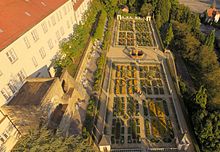
The bitter orange garden is the only preserved terrace garden from the high renaissance period in Germany . It was laid out in 1609 on behalf of the Duchess Sibylla von Württemberg , when the castle was converted into the widow's seat of the Württemberg duchesses. From 1742 the bitter orange garden was used for growing fruit and vegetables until it was restored in 1980 according to Heinrich Schickhardt's original plans .
The city park, which opened in 1979, is located between Leonberg and Eltingen and was created on the site of a gypsum works that ceased operations in 1977. Gypsum quarries were integrated into the facilities as lakes. Many sculptures are set up in the city park. A peace memorial was erected in the south of the park , at the entrance of which a segment of the Berlin Wall has stood since 1990 , which previously stood on the border of the Leonberg partner district Berlin-Neukölln.
Sculpture designed by Hans Daniel Sailer in the Peace Memorial
Heads of Herbert Baumann in the city park
Stream by Ernst Günter Herrmann
Bridge from Heide Bihlmaier
Globe world by Klaus Duschat
The Mindful by Waldemar Grzimek
Regular events

- The five-day Leonberg horse market takes place in February . The conclusion and highlight is the pageant, which takes place on the second Tuesday of the month and in 2010 had over 35,000 spectators. The horse market was approved by Duke Friedrich Karl on January 15, 1684 and took place for the 328th time in 2019.
- The old year evening celebrations take place on December 31st on the marketplaces of Leonberg and Eltingen. According to tradition, this celebration with candles, music and a speech by the mayor has existed for centuries. Widespread, but historically questionable, is the assumption that the origin lies in the plague epidemic of 1635, according to which houses where residents still lived were marked with candles.
- The old town spectacle organized by the advertising associations, the parish and the city with the classic car meeting Leo-Motor Classic (22nd time in 2018), church square festival and Sunday shopping takes place in September. In earlier years cabaret was also performed in the old town cellars.
- The two-day Eltinger Street Festival organized by the Musikverein Lyra Eltingen 1897 eV will take place in June, 2019 for the 47th time.
- The Leonberger Musiknacht has been held since 2006 , until 2011 under the name Nightgroove . Live music is played throughout the night in many of the city's bars.
- The Waldmeister run in Warmbronn with more than 1,500 participants took place for the 43rd time in 2019. A half marathon has been part of the fun run since 2010 . The Leonberg City Run has been held annually in the city center since 2010.
- The three-day rock festival Warmbronner Open Air , also known as rockXplosion , has been held annually since 1985 on the old forest sports field in the Warmbronn district.
- The forest festival of the Höfingen music association takes place on the last weekend in June . The festival at Höfinger Waldeck has been celebrated since 1926, making it the oldest Höfinger festival. The forest festival traditionally begins with a march by the music association through Höfingen and attracts over a thousand visitors every year.
- At the Strohländle on Engelberg, which has been taking place since 2012, there are daily events and hands-on activities for one month in the summer. The appearances of popular cover bands with around 2,000 viewers each are particularly popular .
- Leonberger wine will be served at the four-day Eltinger Wengerterfest in Oberen Feinau, in 2019 for the 22nd time.
- Events on the former Solitude racetrack are the Solitude Revival classic car racing festival , the Glemseck 101 motorcycle meeting and the ADAC Bikertreff .
Personalities
literature
- Bärbel Häcker: Back then, in the tannery town of Leonberg . Bärbel Häcker, Leonberg 2012, ISBN 978-3-00-037540-8 .
- Wilfried Setzler u. a .: Leonberg - an old Württemberg town and its communities in the course of history. Stuttgart 1992
- Kuhn, Volker: Leonberg and Eltingen. History of their merger. Contributions to the history of the city Volume 11, Leonberg 2015, ISBN 978-3-933636-12-6
- Monica Mather and Renate Stäbler: Warmbronn - history of an old Württemberg area. Contributions to the history of the city Volume 10, Leonberg 2009, ISBN 978-3-933636-11-9
- Eberhard Walz: A walk through 700 years of Leonberger economic history 1248 / 49–1948 / 49. Contributions to the history of the city Volume 9, Leonberg 2005, ISBN 978-3-933636-09-6
- Joachim Baur and Birgit Wörner (eds.): Concentration camp and forced labor in Leonberg. Contributions to the history of the city Volume 8, Leonberg 2001, ISBN 978-3-933636-06-5
- City archive Leonberg (Ed.): Forays through 750 years of Leonberg city history. Contributions to the history of the city Volume 7, Leonberg 2000, ISBN 978-3-933636-04-1
- Renate Dürr among others: nun, maid or councilwoman. Women's life in Leonberg from four centuries. Contributions to the history of the city Volume 6, Leonberg 1998, ISBN 978-3-933636-02-7
- Anneliese Seeliger-Zeiss, Volker Trugenberger, Eberhard Walz: “a blissful end and a happy life”. The Leonberg tombs by the sculptor Jeremias Schwartz in their social and art-historical significance with a study of the early architectural history of the city church. Contributions to the history of the city Volume 5, Leonberg 1998, ISBN 978-3-9803587-9-8
- Ernst and Lilienne Haaf: "I läb no!" - The Leonberg hospitals - history and stories. Contributions to the history of the city Volume 4, Leonberg 1996, ISBN 978-3-9803587-7-4
- Eberhard Walz: Johannes Kepler Leomontanus - Obedient Underthan and Burgerssohn von Löwenberg. Contributions to the history of the city Volume 3, Leonberg 1994, ISBN 978-3-9803587-3-6
- Ulrich Keicher: "Slumber gently, your modern bones". Leonberger literary history from the Middle Ages to today. Contributions to the history of the city Volume 2, Leonberg 1994
- Clemens Heucke: The so-called Leonberger Landtag. Contributions to the history of the city Volume 1, Leonberg 1993, ISBN 978-3-9803587-0-5
- Achim Landwehr : Policey in everyday life. The implementation of early modern police regulations in Leonberg. Klostermann, Frankfurt a. M. 2000, ISBN 3-465-03045-1 .
- Volker Trugenberger: Between the castle and the suburb. Social history of the city of Leonberg in the 16th century. Melchior, Vaihingen / Enz 1984, ISBN 3-924275-03-3 .
- Württemberg city book ; Volume IV Sub-volume Baden-Württemberg Volume 2 from Erich Keyser: German city book. Handbook of urban history - on behalf of the working group of historical commissions and with the support of the German Association of Cities, the German Association of Cities and the German Association of Municipalities. Stuttgart 1961.
- Bärbel Häcker: Softly, softly, there is someone lying there again ... In the Leonberg of the Weimar Republic. Self-published, Schwetzingen 2005, ISBN 3-00-017095-2 .
- Ulinka Rublack: The Astronomer & the witch. Johannes Kepler's fight for his mother. Oxford 2015, ISBN 978-0-19-873677-6
Web links
- Web presence of the city of Leonberg
- Link catalog on Leonberg at curlie.org (formerly DMOZ )
- Johanniterspital Leonberg in the database of monasteries in Baden-Württemberg of the Baden-Württemberg State Archives
Individual evidence
- ↑ State Statistical Office Baden-Württemberg - Population by nationality and gender on December 31, 2018 (CSV file) ( help on this ).
- ↑ The markings of Leonberg and Sindelfingen have a point of contact on the L 1188, at the "Frauenkreuz" on the old Solitude race track
- ↑ State Statistical Office, area since 1988 according to actual use for Leonberg.
- ↑ Source: Ortslexikon BW (ONDB) ( Memento of the original dated November 9, 2015 in the Internet Archive ) Info: The archive link was inserted automatically and has not yet been checked. Please check the original and archive link according to the instructions and then remove this notice.
- ↑ Eberhard Walz, Katharina Kepler - the "Witch of Leonberg" , in Renate Dürr among others: nun, maid or councilor. Women's life in Leonberg from four centuries , Leonberg 1998, pp. 82–84
- ^ At Alemannia-Judaica.de: Concentration camp cemetery within the municipal cemetery Seestrasse and the Blosenberg memorial
- ↑ Renate Stäbler / Monica Mather: Difficulties in remembering. About how the Leonbergers dealt with the concentration camp after 1945 . In: From Schönbuch and Gäu. Issue 1. 2003.
- ^ Federal Statistical Office (ed.): Historical municipality directory for the Federal Republic of Germany. Name, border and key number changes in municipalities, counties and administrative districts from May 27, 1970 to December 31, 1982 . W. Kohlhammer, Stuttgart / Mainz 1983, ISBN 3-17-003263-1 , p. 460 .
- ↑ The "Archidiakonat St. Trinitatis ac Omnium Sanctorum" (translated: "Holy Trinity to All Saints"), which existed until the Reformation, was divided into the district chapters Weil der Stadt , Grüningen (today Markgröningen) and Vaihingen .
- ^ Leonberg on Leo-BW, accessed on May 5, 2014.
- ↑ Benjamin Grau: Leonberg: Much motorcycle noise , Stuttgarter Nachrichten, August 5, 2012
- ↑ Cars with a red sticker must stay outside ( Memento from March 22, 2014 in the Internet Archive ) Leonberger Kreiszeitung, November 11, 2011, accessed on November 2, 2012
- ^ KC Verwaltungs GmbH (ed.): Leonberg - City with flair! (No longer available online.) Archived from the original on March 9, 2013 ; Retrieved on April 16, 2012 (The photo shows the Römergalerie, across the street on the other side of the intersection you can see the roof of the Leo Center at the bottom of the picture.). Info: The archive link was inserted automatically and has not yet been checked. Please check the original and archive link according to the instructions and then remove this notice.
- ↑ Advertising association Faszination Altstadt Leonberg e. V. (Ed.): Business. Retrieved April 19, 2012 .
- ^ Elektro und Lichthaus Knapp GmbH / Elektro Bader GmbH (ed.): Overview plan of the advertising association. Retrieved April 19, 2012 .
- ↑ Bosch in Leonberg website of the Bosch company, accessed on August 10, 2019.
- ↑ An important step for the large Bosch site. In: leonberger-kreiszeitung.de , March 26, 2019.
- ↑ Citizens' decision on indoor swimming pool Stuttgarter-Zeitung.de, January 31, 2012, accessed on February 11, 2014.
- ↑ Refurbishment breaks twelve million mark Stuttgarter-Zeitung.de, March 14, 2013, accessed on February 11, 2014.
- ↑ Silent Night in the indoor swimming pool: opening tilted Stuttgarter-Nachrichten.de, December 5, 2013, accessed on February 11, 2013.
- ↑ Liederkranz 1840 Leonberg e. V.
- ↑ Musikverein Lyra 1897 Eltingen e. V.
- ^ Leonberg Symphony Orchestra
- ↑ Music school Villa Musica e. V.
- ^ The Laurentiuskirche Höfingen , parish Höfingen, accessed October 28, 2010
- ↑ The Laurentius Church in Höfingen ( Memento of the original from March 22, 2014 in the Internet Archive ) Info: The archive link was automatically inserted and not yet checked. Please check the original and archive link according to the instructions and then remove this notice. , Zeitreise BB, accessed October 28, 2010
- ↑ Seehaus Leonberg - Juvenile prison system in free forms Seehaus e. V., accessed on July 27, 2015.
- ^ Gypsum mining in Eltingen , Zeitreise-bb, accessed February 8, 2012
- ↑ The Berlin Wall in Leonberger Stadtpark ( memento from July 15, 2012 in the web archive archive.today ), Stuttgarter Zeitung , article from November 7, 2009
- ^ A parade full of colorful stories along the way ( memento from February 26, 2014 in the Internet Archive ), Stuttgarter Zeitung , February 10, 2010
- ^ The Leonberg Horse Market - the traditional highlight of the year , accessed on February 11, 2014.
- ↑ Old Year's Eve celebrations on New Year's Eve , City of Leonberg, accessed August 22, 2010.
- ↑ The Eltinger Street Festival and Change ( Memento from September 10, 2012 in the web archive archive.today ), Stuttgarter Zeitung , published on June 18, 2010.
- ↑ Events of the Musikverein Höfingen , MV Höfingen, accessed on November 14, 2010.
- ↑ Games, fun and 30 tons of straw. Leonberger Kreiszeitung, August 3, 2017.
- ↑ Positive balance: around 30,000 people are coming. Leonberger Kreiszeitung, September 3, 2018.

